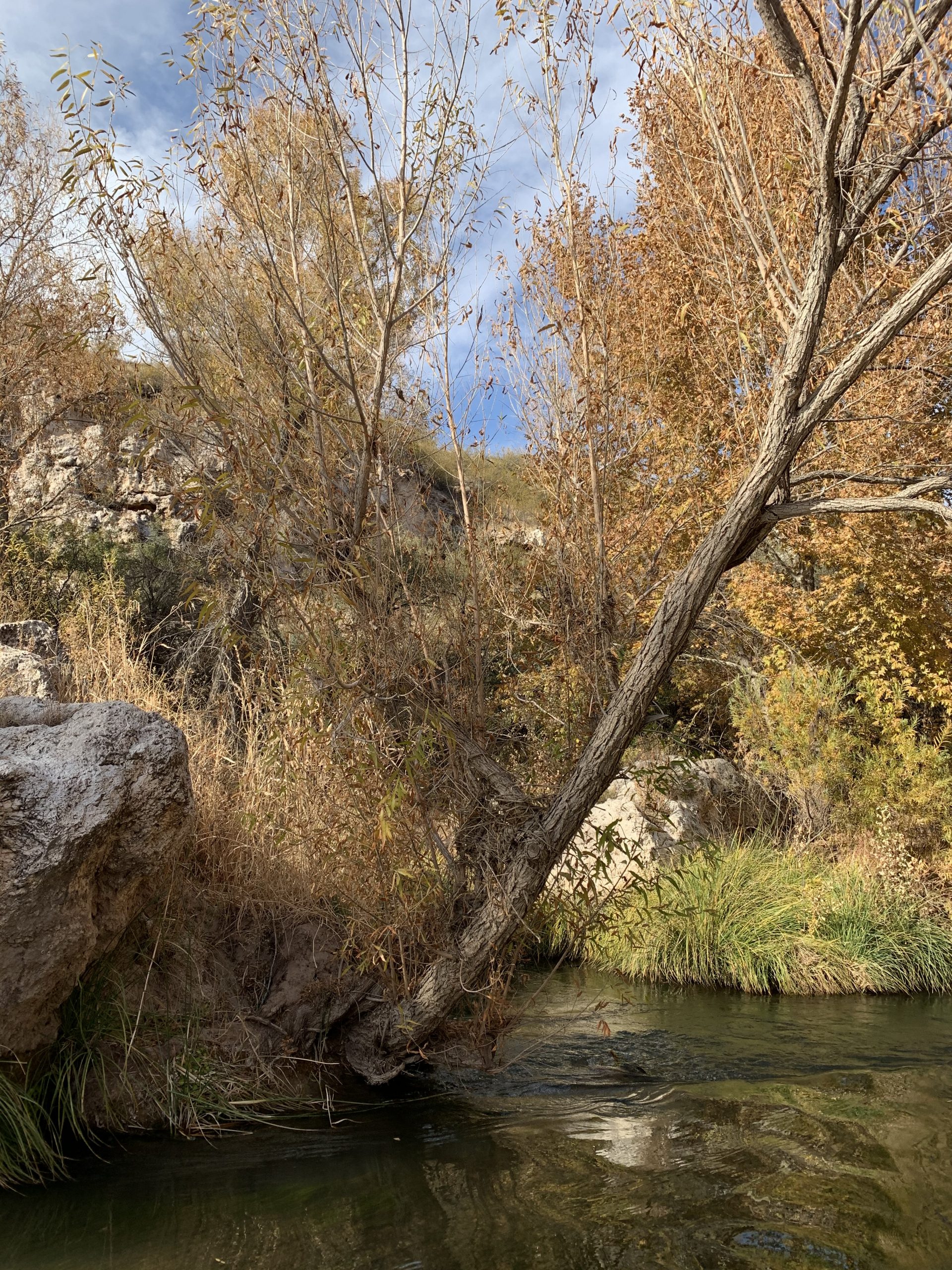Learn
by Nancy Steele
September 13, 2021
If you don’t already celebrate rivers enough, this month we celebrate World Rivers Day on Sunday, September 26th. Why should you celebrate the Verde? Let me count the ways.
Racing downhill, waters from rivers carve the lands, down cutting through soft sediments and hard bedrock, creating pathways. The Verde River is often a muddy brown color from the high loads of sediment it carries. All that sediment flows downhill where it is stopped by Horseshoe Dam. Over one-third of Horseshoe Dam’s original capacity to hold water is now filled up with sediment that flowed downhill from the Verde watershed.
Irrigating orchards and fields, ditch diversions from the Verde River and Oak Creek are as old as time. The earliest known and currently in-use ditch dates from 1200 A.D. The oldest operational ditches built by white settlers in the Verde Valley in 1865 are the Pioneer Ditch and the Wingfield #4 Ditch. Ditches can starve the river of water when they divert all the water, returning unused and often polluted water downstream. Today, many of the ditches have been modernized with remote controlled headgate controls, allowing for more efficient use of river water. These modernized headgates keep more water in the river while meeting the needs of irrigators. We look forward to the day when all Verde Valley ditches are modernized.
Valuing rivers is not easy. Who wants to try to attach dollars to everything we get from rivers? There is a field of science called ecosystem services that attempts to do just that. In 2019, for example, Arizona Audubon determined that water-related recreation in Arizona was valued at $13.5 billon. Some values are intangible. We may want rivers to exist simply because we enjoy them. There are people who support Friends of the Verde River, for example, but who have never even seen the Verde River. They just like the idea what it exists and want to see our rivers stay flowing and healthy.
Enjoying a day on the river is something we can all celebrate. One of my treasured memories is of lying on a rock beside Christopher Creek when I was pregnant with my son. I remember the peace I felt, listening to the burbling water, watching the patterns of green and light from the cottonwood trees, reflected on the water.
Recycling nutrients is a more polite way to talk about decomposition and rot. In balance, this is a good and necessary thing. Decomposition makes nutrients available for new life. But there can be too much of a good thing when a river system has too many nutrients (aka nitrogen and phosphorus). This summer I saw a patch of the Verde that was both clear and bright green. I suspected that the bright green represented a bloom of algae. Too much algae in the water will paradoxically starve a river. The algae consume too much oxygen, killing other living things. How does a river get too much nitrogen and phosphorus? If you use too much fertilizer, the excess nutrients flow into the river. There are two things you can and should do. First, be stingier with your fertilizer, applying only as much as recommended. Second, install berms at your land’s edge to keep water on your property, allowing it to puddle and soak in. That way, microbes in the soil can break down excess nutrients before they get to the river.
Lights – human have used the power of rivers to generate electricity, in essence turning water into light using massive turbines. The era of big dam building in the US seems to be over while the rest of the world is on a dam building jag. In the US we no longer consider hydropower to be especially “green,” recognizing that dams have contributed to the extinction crisis in our salmon populations. In 2014, two dams were removed on the Elwha River in Washington State. Within days, Chinook salmon were seen swimming north and within a few years over 10 million cubic meters of sediment had washed out to sea. Fortunately for us, the Verde River is undammed until it gets near Phoenix.
Otters, the playful furbearing mammal we love to see in the Verde, were trapped out sometime in the 1930s, although the last recorded southwestern river otter was killed in New Mexico in 1953. People recognized their error, though, and Arizona Game & Fish relocated otters from Louisiana in 1980. River otters like to eat our non-native crayfish. Etouffee with crawdads, anyone?
Verde Valley – the story of the creation of the Verde Valley is over 1.82 billion years old and has many chapters, involving erosion, ground movement, and deposition. For a while, this place was an inland sea. About 2 million years ago the Verde River formed as the inland sea receded and waters began flowing downhill. The Black Hills to the southwest and the Mogollon Rim to the northeast form the boundaries of the Verde Valley.
Eddies – I like to think of eddies as places of calm. They can be refuges for fish and other small aquatic creatures, places where the water slows down, and you can hang out for a while. When the river floods, backwaters can give protection to the animals that live in rivers, helping them to stay put and allowing the repopulation of a river after floods. When I’m in a kayak, I don’t especially like getting in eddies because they hold me back. But eddies are a good reminder to hang out and chill. Take a breather and relax on the river.
And there you have it. RIVER LOVE. That’s my phrase for today. Celebrate your river today and every day.






